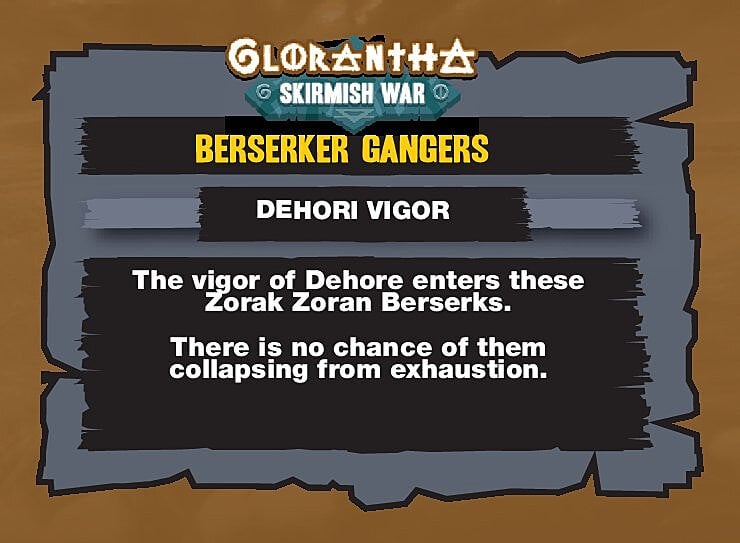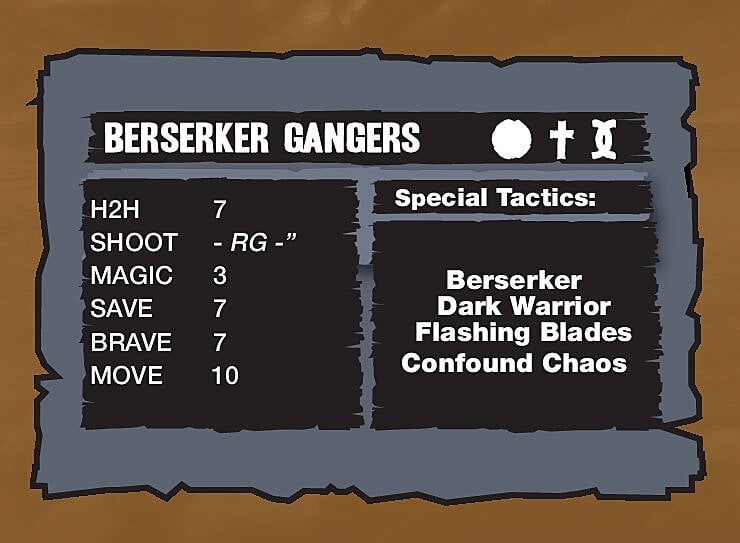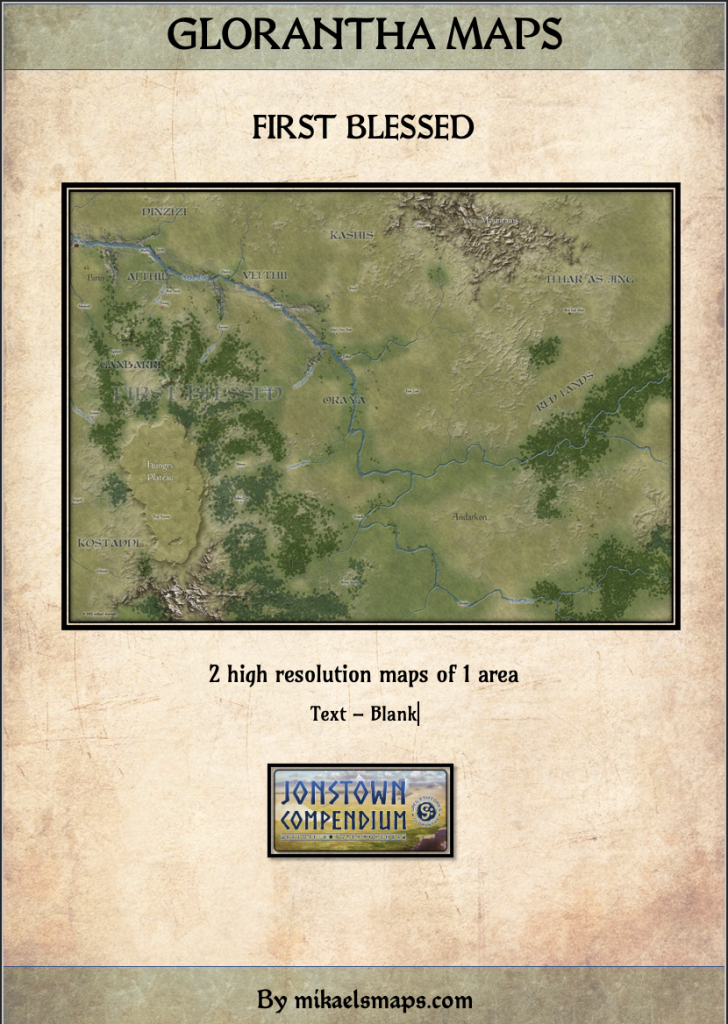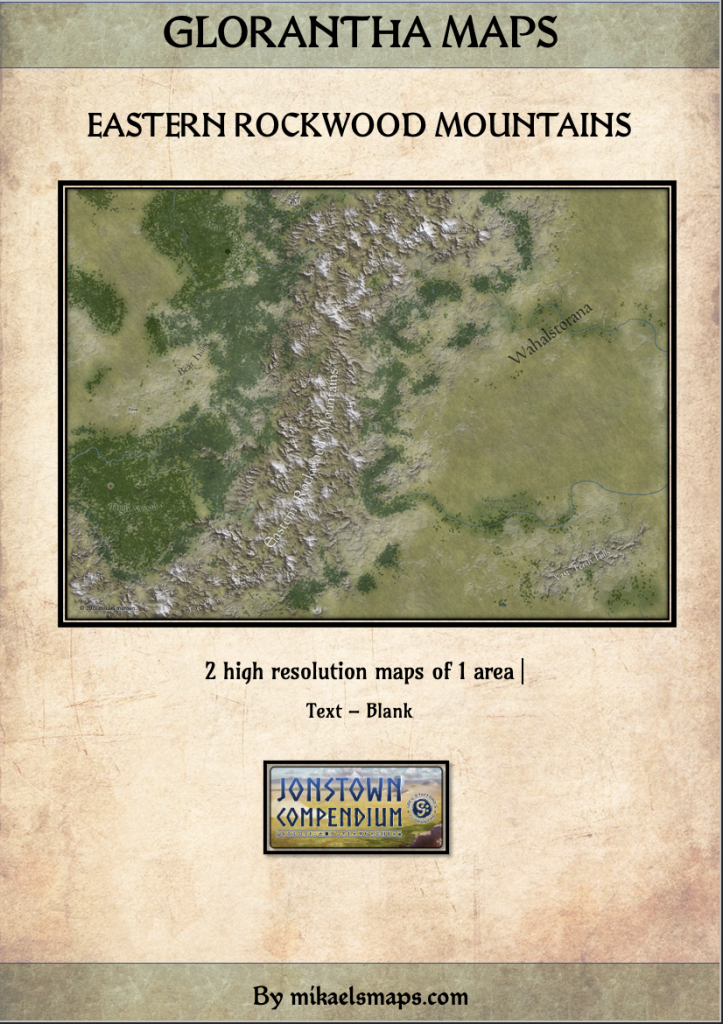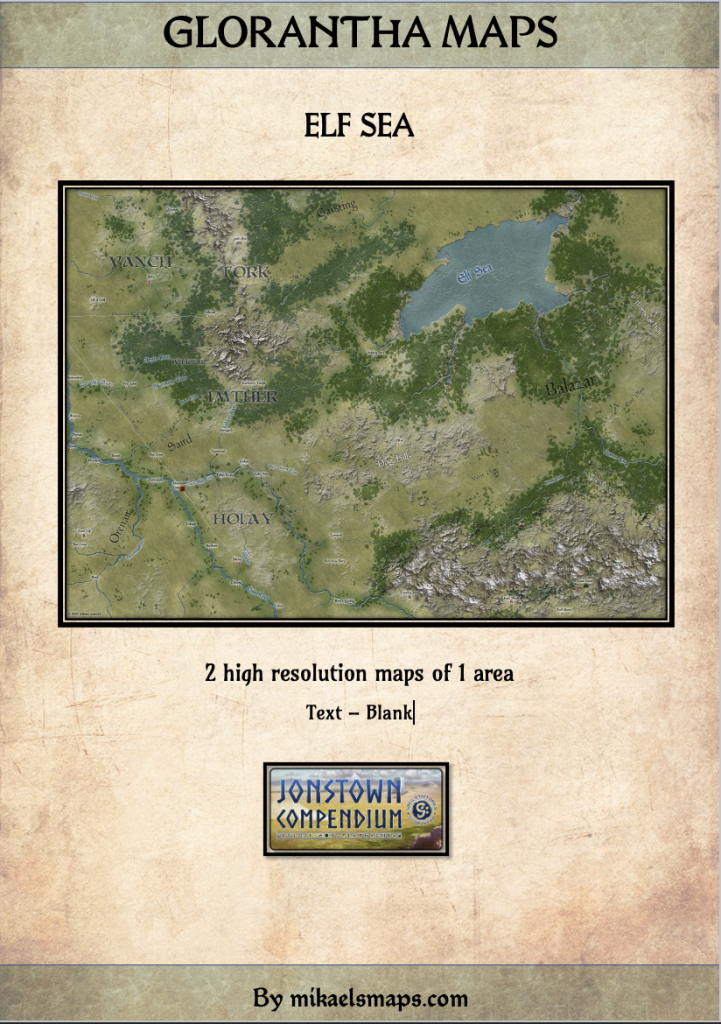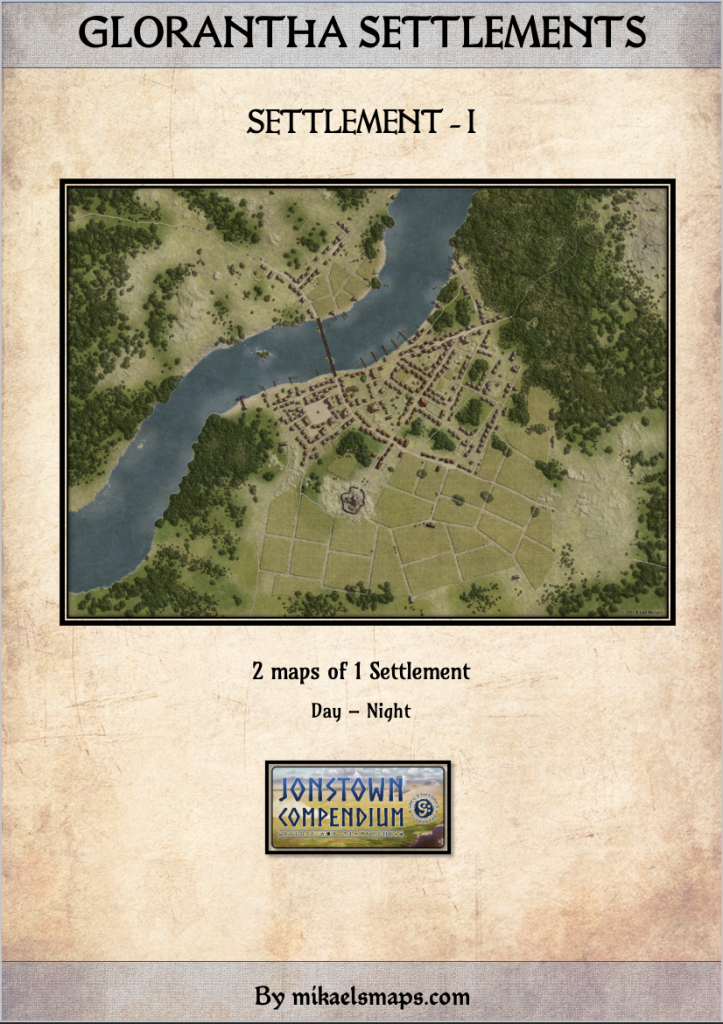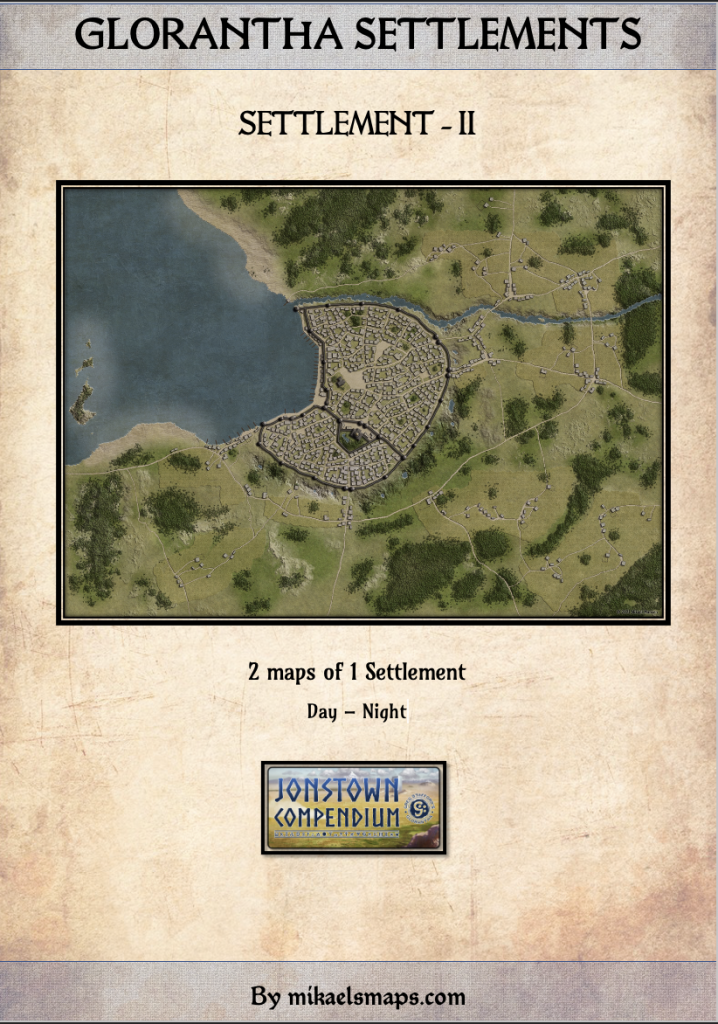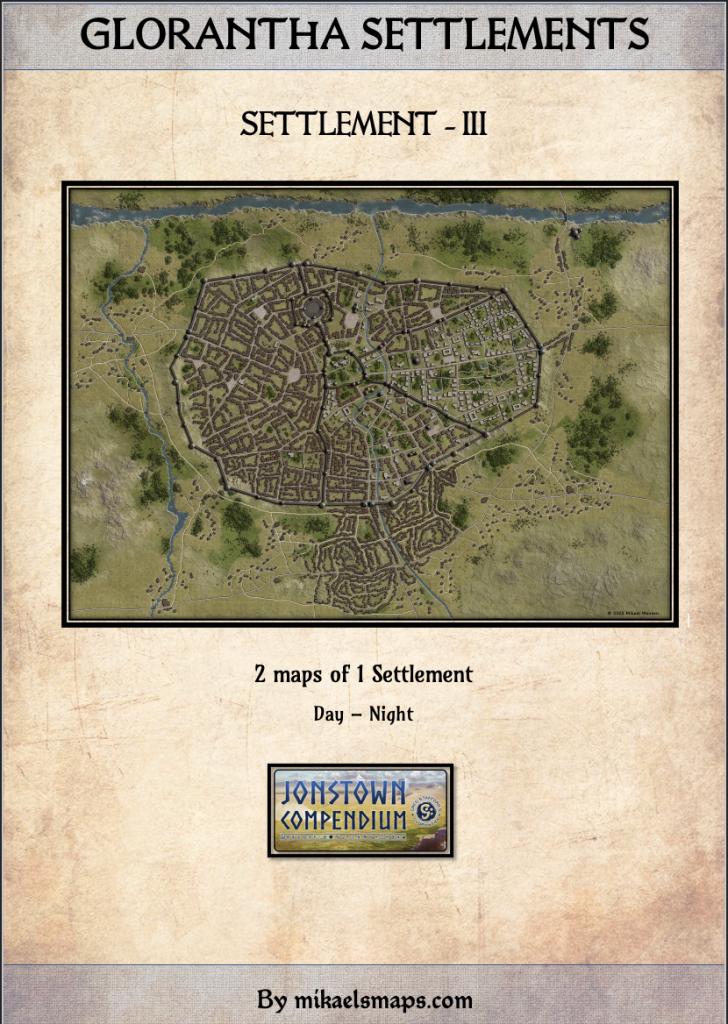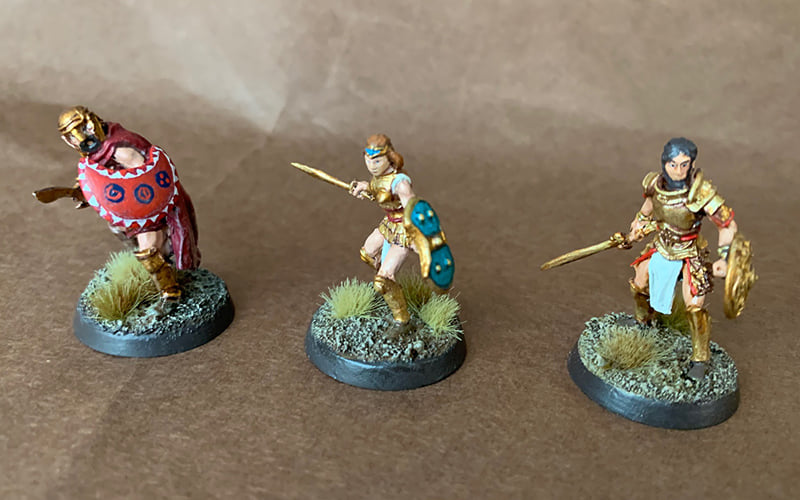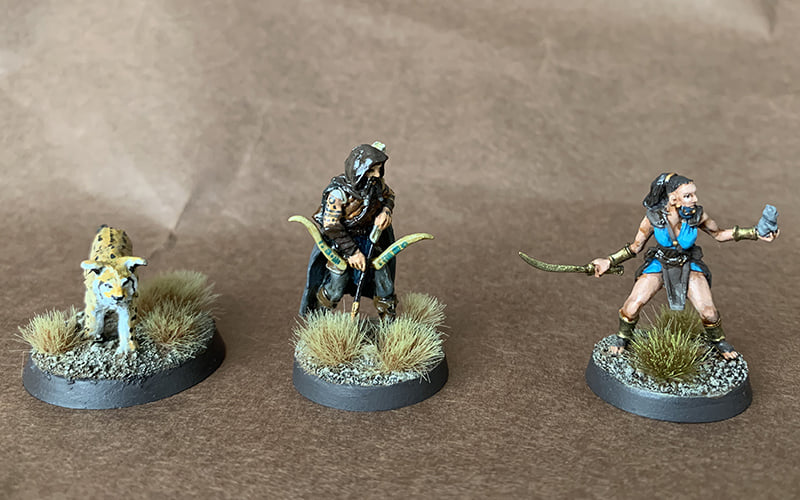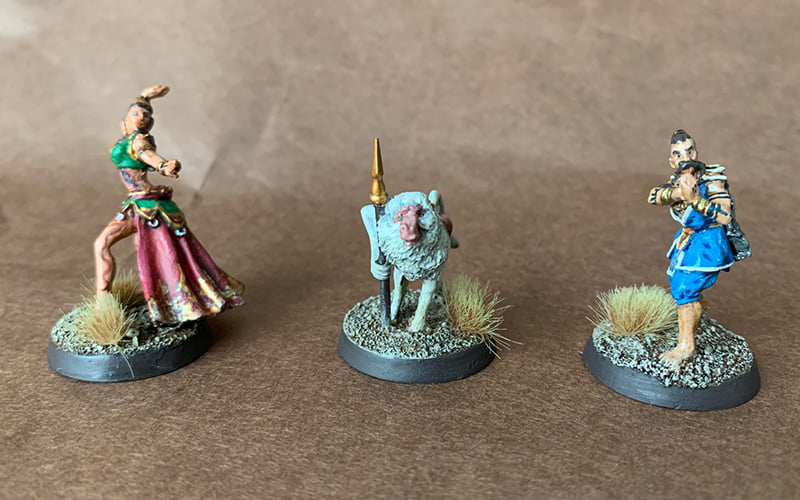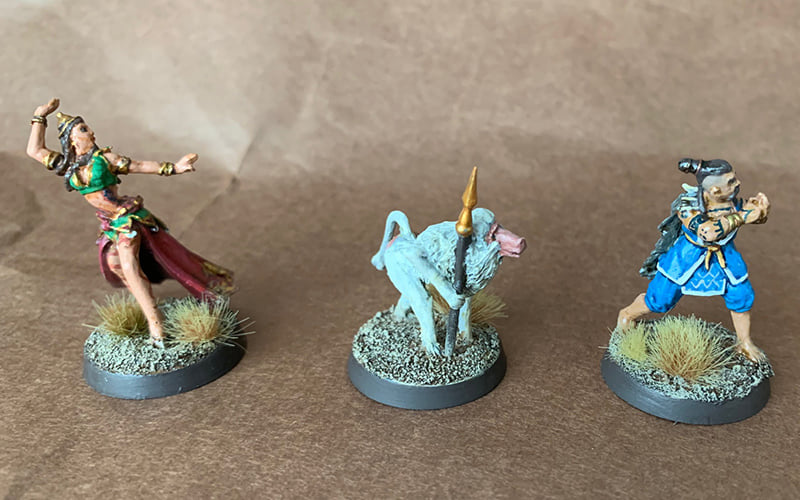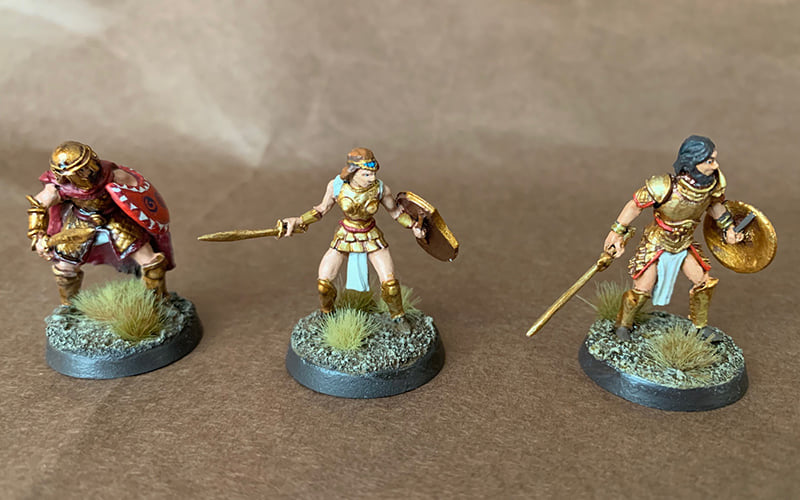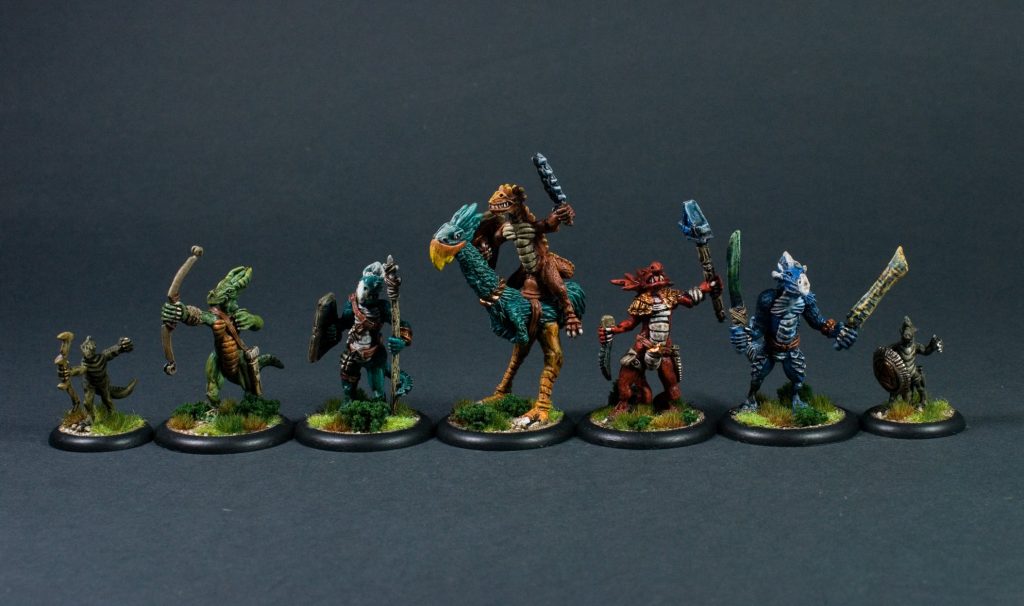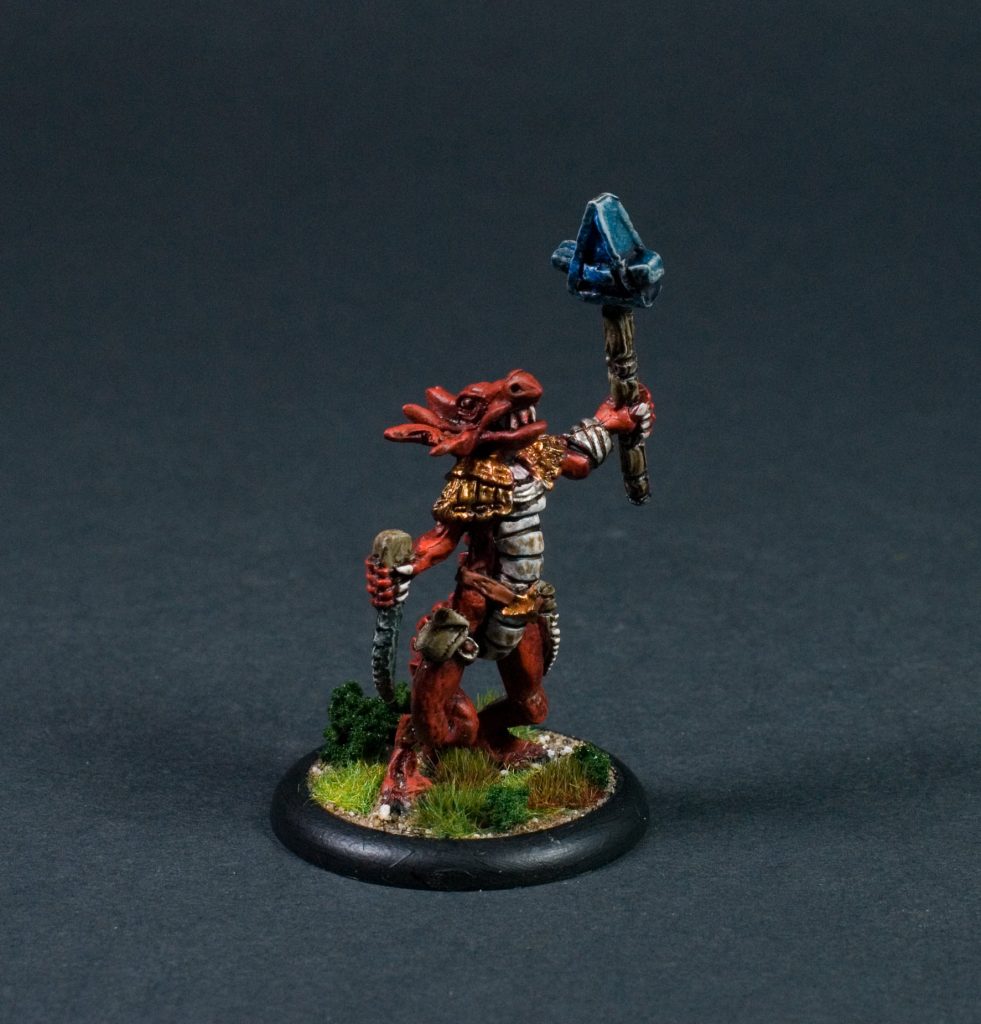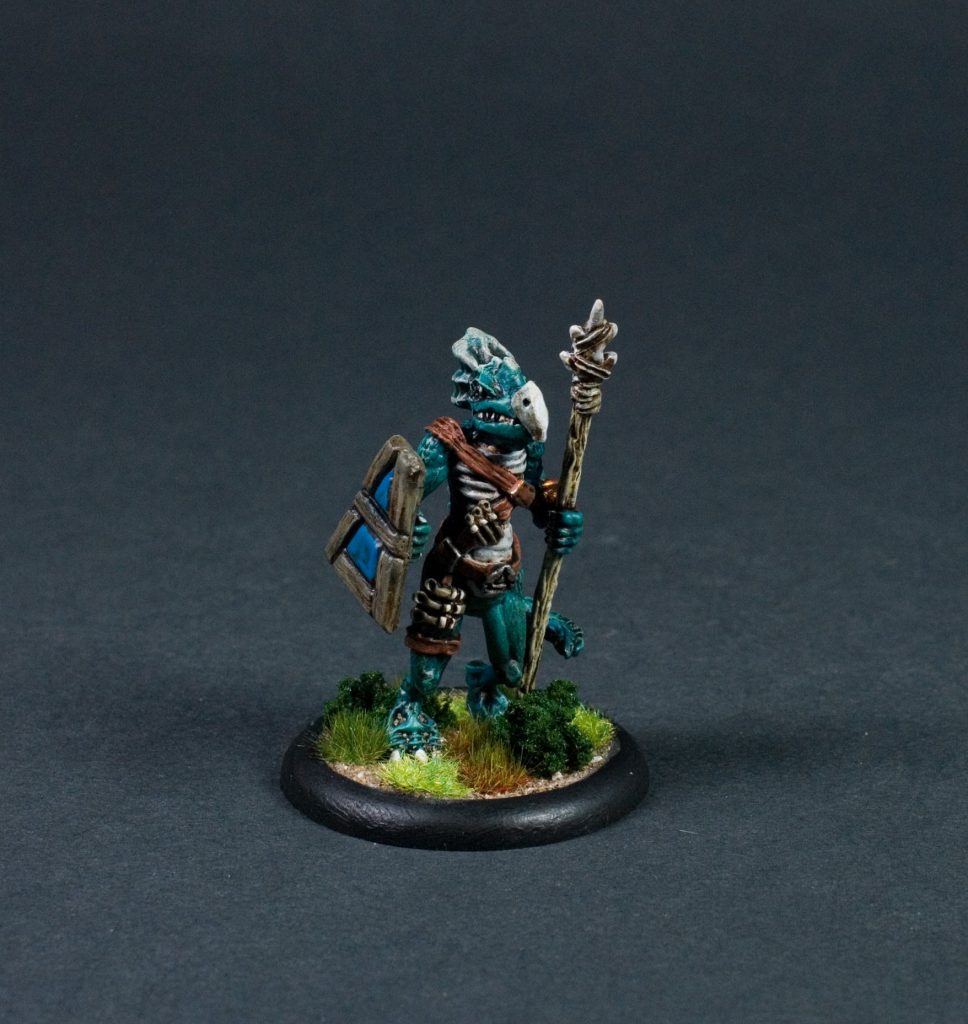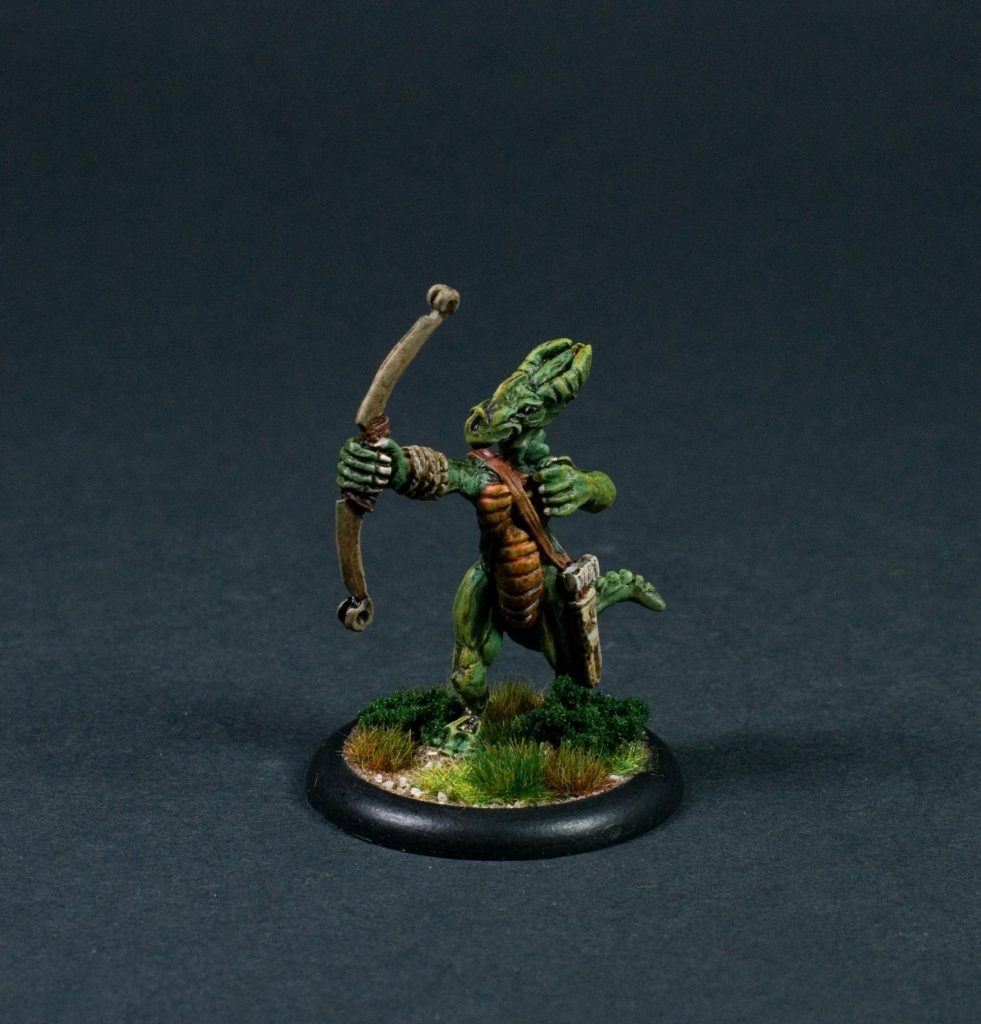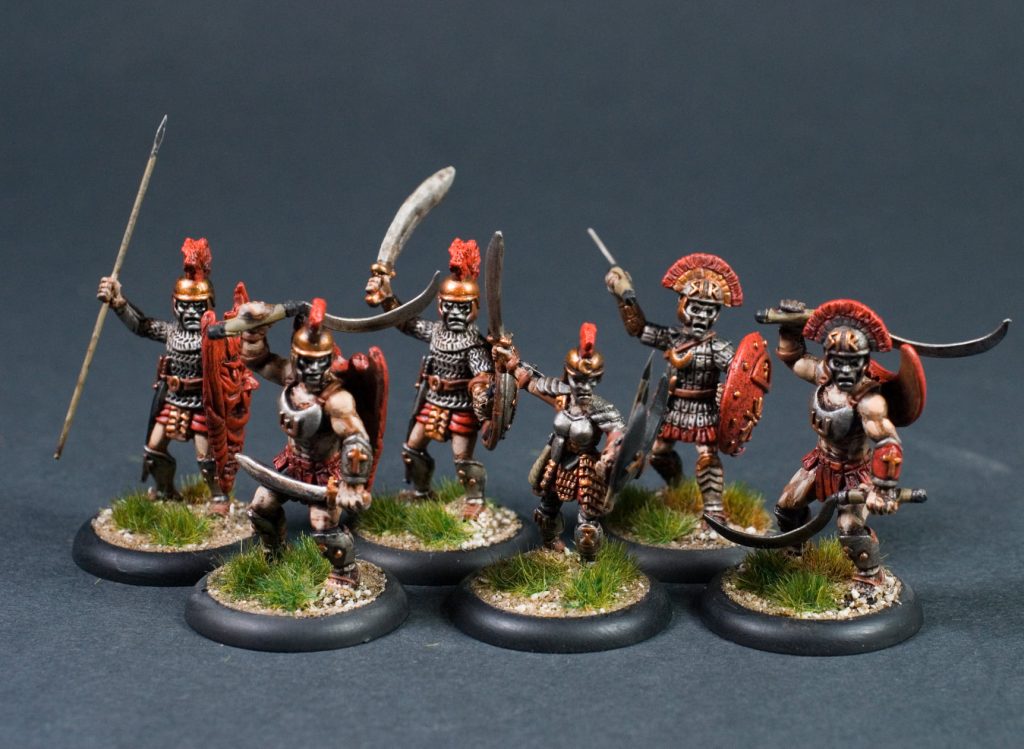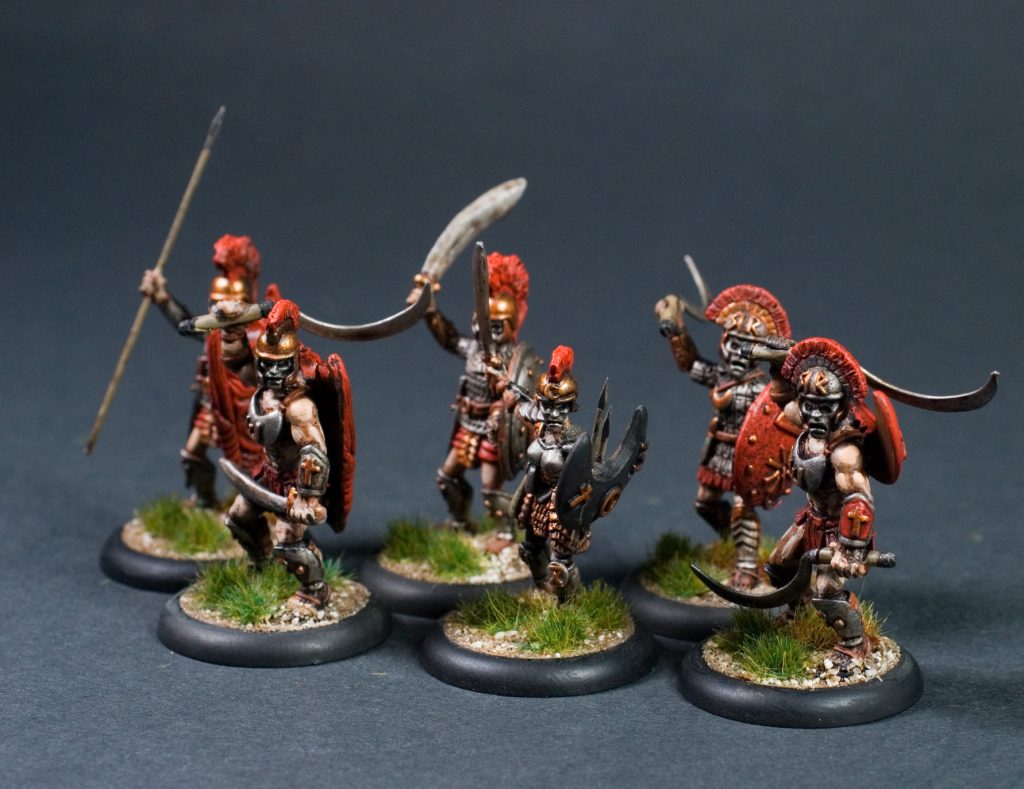Welcome to a new issue of the Journal of Runic Studies, the premfrier Malkioni publication for studies into the nature of Glorantha. If you haven’t subscribed yet, please consult with the spirit bound to the appropriate electronic page.
This is another holiday week, and the heart of ski season… I may not have too much time to collect these Journals as exhaustively as usual, especially since I have the episode 7 of the podcast to finish editing. It should be out in a few days.
By the way, if you want to help by writing a specific section, provide commentary on a specific note from Jeff, or other contribution, please reach out to us! It would help a lot to have more hands and brains on this!
Chaosium News

Here are this week’s Chaosium news!
How Mythology Underpins Glorantha
James continues his interview series with Jeff Richard, and this time we have a short chat about mythology: in Glorantha, in books, in the real-world, in games.
Starter Set Pre-gen Miniatures

Richard Helliwell of Infinity Engine shared this work-in-progress version of Makarios, one of the pre-gen characters from the Starter Set. The plan is that all those pre-gens are available in miniature form eventually! Infinity Engine already had the miniatures for the Quickstart adventure, along with several other cool things.
Glorantha Skirmish War Updates
Speaking of official licensees for miniatures, Andrew Taylor of Mad Knight Castings shared a few updates about the Gloranthan skirmish game that he was working towards with his many Kickstarted miniature lines. The project had taken a hit, between the global COVID pandemic and Andrew’s personal health problems, but it sounds like he’s getting back on track. Here’s some preview and design notes on unit cards:
The richness of Glorantha is both a beauty and a nightmare. Whilst many excellent skirmish rule sets exist none easily lend themselves to a Glorantha setting. I started with an A5 size UNIT card containing UNIT stats, Leader stats, pictures and magical abilities. It worked ok up to a point, but coupling the leaders to the UNITS and to the Magic became inflexible. So I split leaders and non unit specific magic off into separate cards. The card size shrunk from A5 to poker size. This, for UNITs, generated a new problem- how to fit pictures of the figures and all the info onto a 63*88 card ?
We tried many different layouts but to no avail. The pictures had to go off the cards and into the armies book.
Here is the front and back of a Troll Unit. On the front is the UNIT Magical Highlight, on the back the UNIT stats, the UNIT runes, and the UNIT special tactics.
Recent Well of Daliath Additions
The Well of Daliath website is Chaosium’s online repository for Gloranthan Lore and RuneQuest clarifications and errata. It has some awesome content such as, say, an index of all White Dwarf articles for RuneQuest. It also has monthly archives of notable Facebook postings by Jeff Richard or Michael O’Brien, though without the commentary we provide here in our Journal of Runic Studies (which might be a good or bad thing depending on your opinion of it!)
The RuneQuest Q&A was recently updated with clarifications of the sorcery rules and the errata for sorcery spells. Gloranthan lore recently saw newly archived “Greg sez” articles, or detailed notes on Sandy Petersen’s 1984 Campaign.
There is a whole treasure trove of information in there… I’m a big fan of the Prosopaedia archive, which has the Runes of a lot of deities per publication, so you can see how their Runes changed (or not) across game lines. Another one I frequently consult is the giant Third Age Timeline of Dragon Pass, which helps collate various sources easily. It is divided in several chunks of history, each with their own page. Note that it only draws on official RuneQuest and general Glorantha publications up to and including the GM Screen package, and ignores dates e.g. from any of the HeroQuest publications or from the Stafford Library book “History of the Heortling Peoples” or “The Fortunate Succession”.
David Scott is the librarian behind the Well of Daliath, but several volunteers help here and there with the website. You can contact him to get involved!
Jonstown Compendium

The Jonstown Compendium is Chaosium’s community content program for all Gloranthan games, hosted on DriveThruRPG. Disclaimer: all the relevant links are affiliate links that hopefully will let us cover some of the hosting and maintenance costs for the website and podcast! Thanks for using them!
To Hunt a God
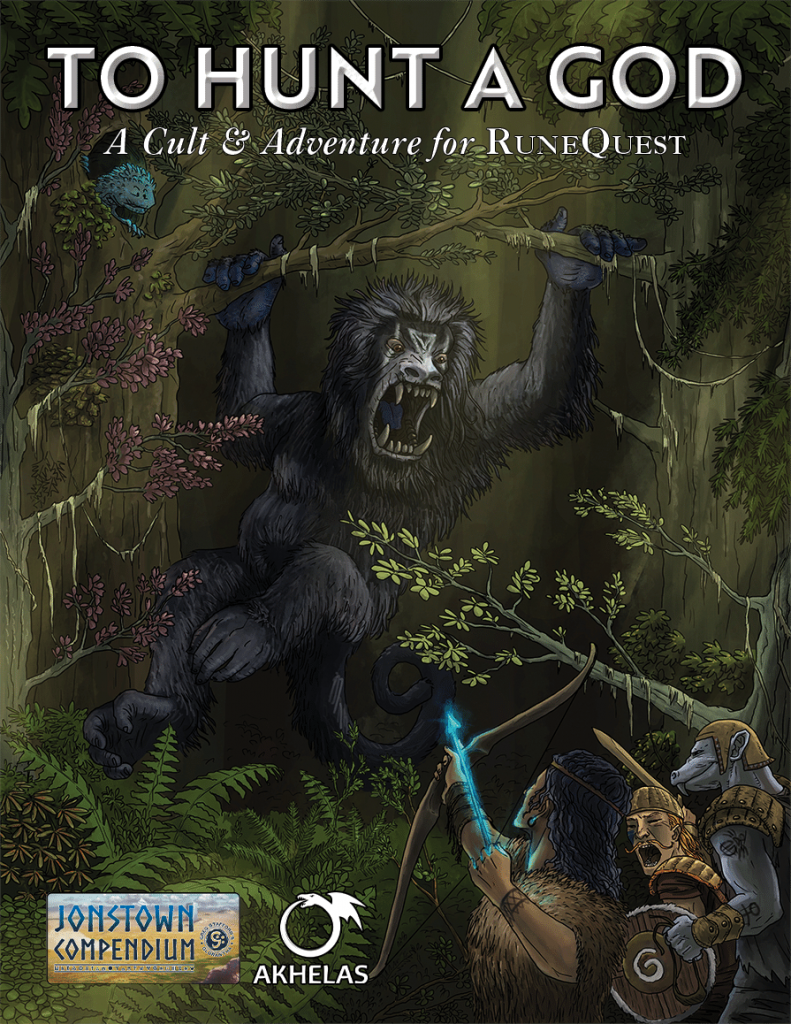
The final-but-not-so-final issue of Monster of the Month Volume 2 is now out! To Hunt a God describes the crazy monkey cult of Hrunda who lives in the Old Woods of Esrolia, his “Temple of Bones”, and the first part of an adventure that sends you after him. Don’t forget to try Ludvik’s Liquor, it’s delicious and totally good for you.
Holiday Dorastor: Joulupukki
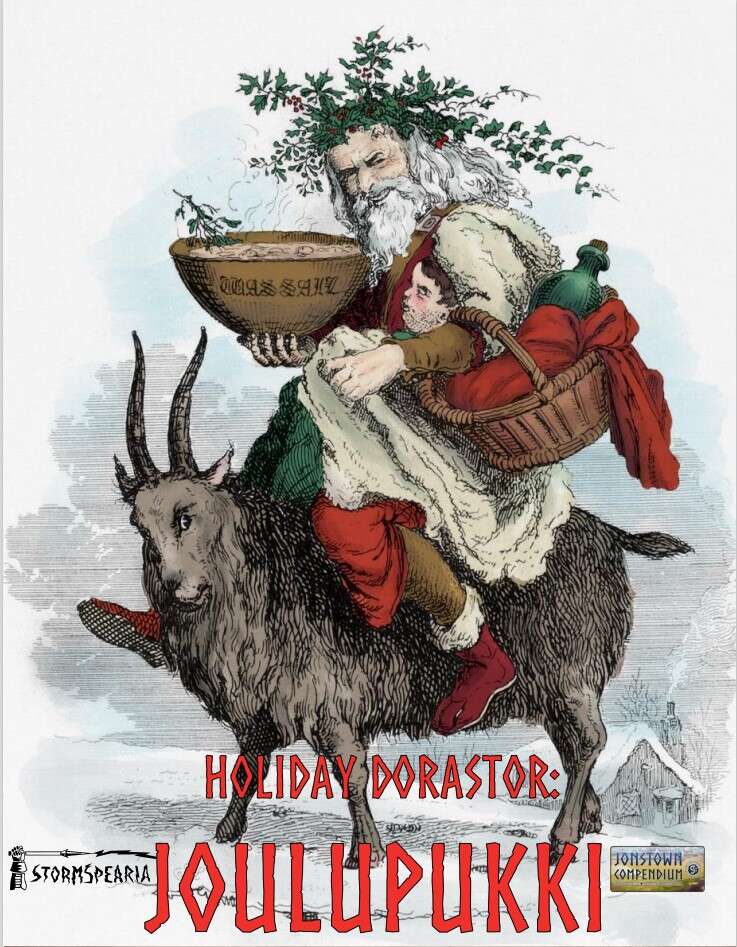
After the mean and ugly Krampuslauf, Stormspearia are now releasing Joulupukki, the apparently nice jolly good man who gives children gifts during Sacred Time… but he’s a sub-cult of Eurmal the Trickster God so who knows what he’s really up to?
Gloranthan Maps
Mikael Mansen continues to churn out nice looking parts of Genertela! There’s First Blessed, the Eastern Rockwood Mountains, and the Elf Sea. There’s also a three generic settlement maps.
Teaser of the Periplus of Southern Genertela
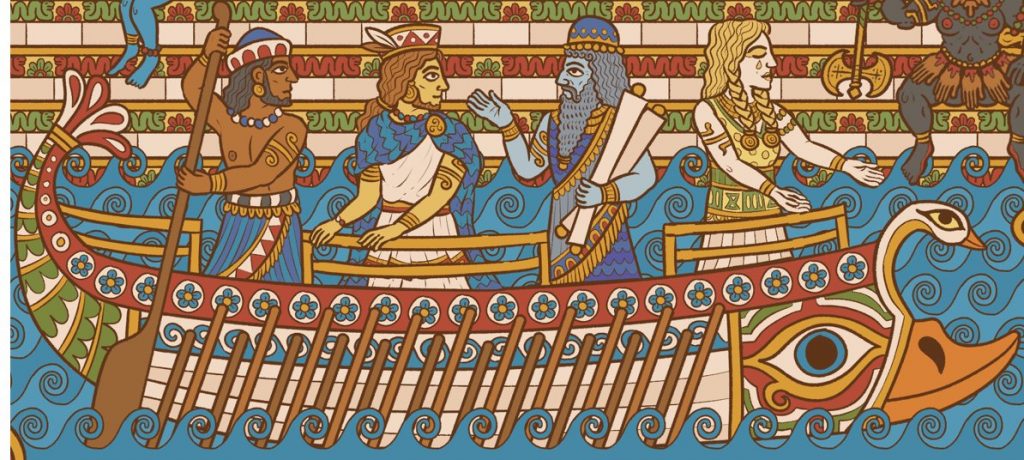
Martin Helsdon continues to tease his next Jonstown Compendium project which, I assume, is something based on his Periplus of Southern Genertela. The project will be illustrated by Katrim Dirim. The picture above supposedly shows Chalana Arroy, Lhankor Mhy, Issaries, and Dormal, and is part of a much bigger picture featuring many more deities and heroes.
Jeff’s Notes

Jeff Richard, the current mastermind on everything Gloranthan at Chaosium, is often posting notes and thoughts on the RuneQuest Facebook group. Here’s our curated list from the past week. A partial archive of these sources is compiled on the Well of Daliath.
Memes in the Second Age
One of the things that are often under-estimated when we think of the ancient world on Earth is how much cultural exchange there was between various part of Europe, Africa, and Asia. Well Jeff is talking about that for Glorantha’s Second Age:
Around the coastal regions of the world, the Middle Sea Empire, with its mix of Malkionism with a smattering of Theyalan and Darkness myths (starting from the Broken Council and Gbaji Wars era, but later built upon with the Dark Empire) and finds parallels in Kralorela, Teshnos, Fonrit, and elsewhere. This leads to the Monomyth – a universal approach to Gloranthan Mythology.
Now many commentators will say “God Learner Lies” or similar nonsense, but the Monomyth worked. It enabled deep exploration of the God Time and experimental heroquests to gain power and rob secrets from their enemies. Like Arabic numbers, the Monomyth was too useful not to be used, and the Empire of the Wyrms Friends eagerly embraced it (which can be viewed as its return to its source – as the origins of the Monomyth was with the First and Second Councils).
I really like this comparison to the Arabic Numbers: they worked, they were better, and everybody started using them. There’s just no arguing about it, and there’s no arguing about how the Monomyth worked and was more useful, from a theological standpoint, than the previous darker ages.
Still, even though Jeff shot down the idea, I can’t help but think about the little details that got lost in the process. Any generalization will, by definition, work in general, but might gloss over the little things. A change in mental framework is often accompanied by many other changes, such as when a 7-day week was introduced in the Roman Empire and that affected people’s habits and conception of time. So in my own Glorantha, there might have been minor gods and spirits lost in the process… when you’re changing your worship rituals to use the Monomyth version of your local goddess, it’s hard to tell if you’re getting access to new and larger mythical truths about her, or if you’re leaving her behind and worshipping a bigger and different goddess altogether! This sounds like a nice way to have an adventure or two where you need to appease one of those shunted deities, or even help them realize they are just a piece of a much bigger goddess who forgot who they were! Having to deal with the amnesiac aspect of Ernalda that makes radishes grow around a hill near Jonstown sounds fun to me!
And so by the height of the Second Age, a working understanding of the Monomyth had spread across much of Glorantha. The Monomyth never fully replaced many traditional names and cults, but it informed them of their greater context.
This is how you tell that radish goddess that she can still be herself, and consider herself a daughter or cousin of Ernalda, I guess?
In the Empire of the Wyrms Friends, the Third Council learned secrets from the dragonewts and wyrms, something entirely consistent with the traditional Orlanthi openness to strangers and new ideas. With aid from mythic maps stolen from the God Learners and with the Monomyth as a framework, experimental heroquests and mythic explorations were common in Dragon Pass, as the lives of such individuals as Gorangi Vak, Ingolf Dragonfriend, Isgangdrang, Lord Labyrgon, and Pavis show.
These God Learners’ mythic maps are available in the Glorantha Sourcebook and the Guide to Glorantha. Jeff shared an early sketch of one of those:
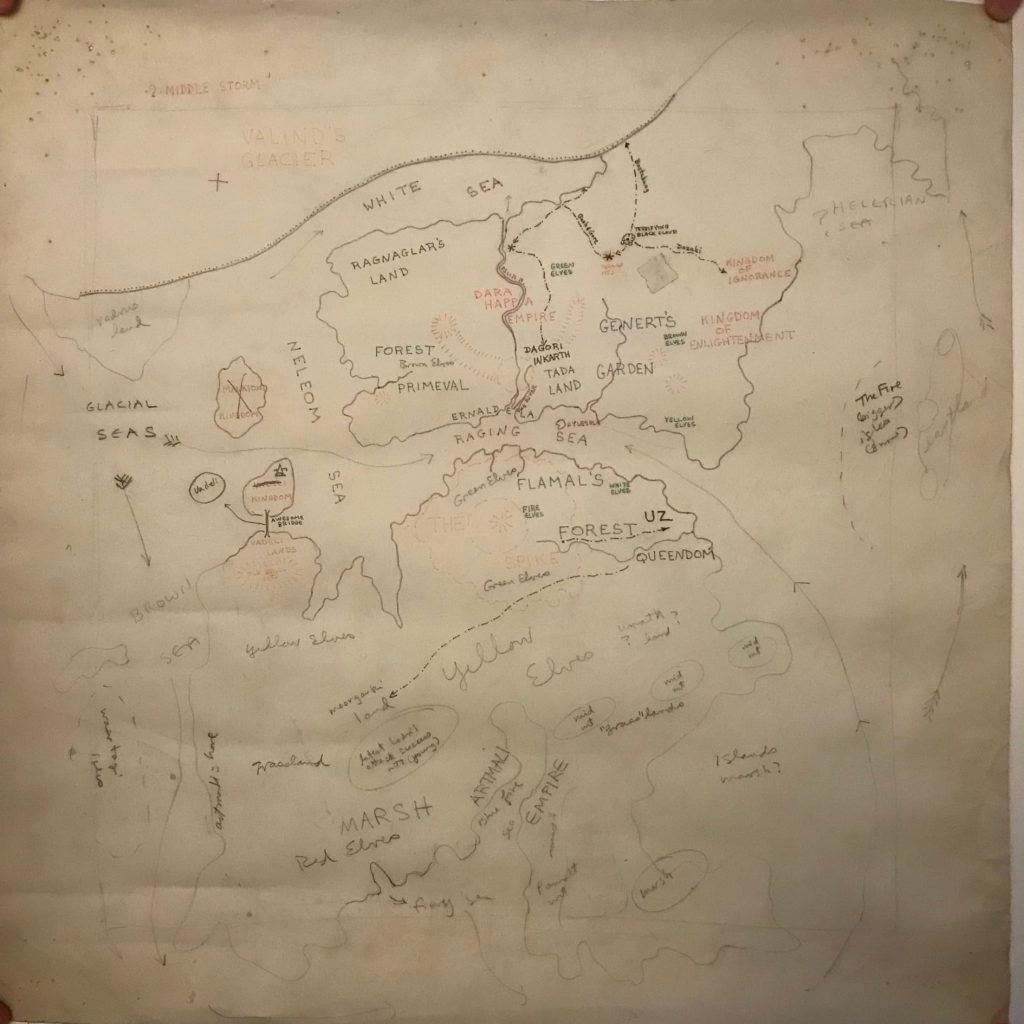
The enemies of the empires also adopted their approach, and such heroes as Alakoring Rex, Iddi Scorchbane, Emperor Karvanyar, and Verenmars would not be possible without the secrets taken from the EWF and God Learners.
The disasters that ended the Second Age largely put an end to this experimental outlook and mythic explorations. With one big exception – the Lunar Empire.
That last sentence is important: the Lunar Empire has kept their heroquesting up consistently over the past centuries, and they continue innovating… the God Learners were just in it to “see how things work”. But:
The Lunars, in contrast, are basically driven by the desire to aid the Red Goddess in remaking the world (we can euphemisize this as “healing the world” if we want). Like the God Learners, personal ambition and the desire to weaponise these secrets factors into this, but I’d say the Lunar interest is much narrower (but deeper) than the God Learners.
Jrustela
Let’s talk about our homeland! (the God Learners’, I mean)
Jrustela was somewhere more than 400,000 square miles in area or about twice the size of Madagascar. Dwarfs, and several species of sentient insects, the Timinits, were indigenous to Jrustela.
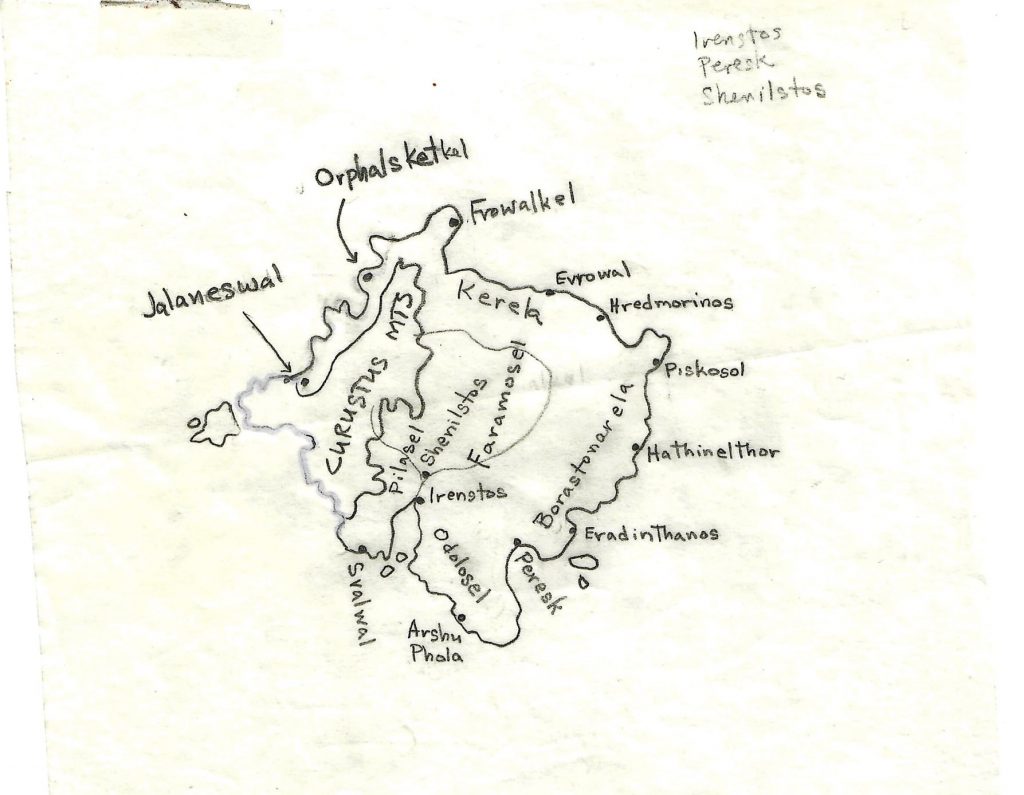
Humans came to Jrustela in the First Age. The initial settlers largely came from Slontos and were brought here by Waertagi dragonships. They called themselves the Olodo, and settled in the interior away from the coasts. They settled in small freeholds and fought with the Timinits.
Slontos was a land on the southern Genertelan shore, west of the Holy Country, which sank in 1050, leaving behind only islands off the (new) coast of Maniria.
The Wartagi are an ancient humanoid amphibian race who sailed the oceans ever since there were oceans to sail, some time in the God Time. They’ve always had an alliance with the Brithini, and had many trade routes across southwest Genertela including Slontos.
This was all good and fine until some problems with royal succession in Seshnela sent a whole bunch of unhappy wizards and nobles to Jrustela:
In the Second Age, the Seshnelan king Nralar son of Gerlant Flamesword died in 603 after ruling for more than a century. Nralar had many eligible and powerful sons to succeed him, and so a council of nobles, Hrestoli adepts, and wizards met to chose a new king. The council chose one of Nralar’s younger sons, Nepur, the older brother having been deemed unfit to rule the kingdom.
Rather than contest the choice of the council, a great many descendants of Nralar left the kingdom, sailing upon Waertagi ships over the ocean to Jrustela. The royal talars were accompanied by their sorcerers and followers. They founded the city of Hredmarinos, and allied with the Olodo against the Timinits. The Seshnegi kept to the coasts, and the Olodo claimed the rugged interior of the island.
So you’ve got wizards and nobles (talars) going to Jrustela, followed by a whole bunch more soon after:
Sadly, the settlement of Jrustela by the Nralarites did not prevent a civil war in Seshnela, and many others fled Seshnela to the comparative peace of Jrustela.
Jeff shares more in another post:
The human settlements on Jrustela grew in number and population. Each settlement was free and independent. At first, this was no problem as there was land and resources enough for all, but within two generations conflicts grew. In 646 the quarrelling rulers and wizards of the city-states and tribes of Jrustela met to reach a lasting settlement.
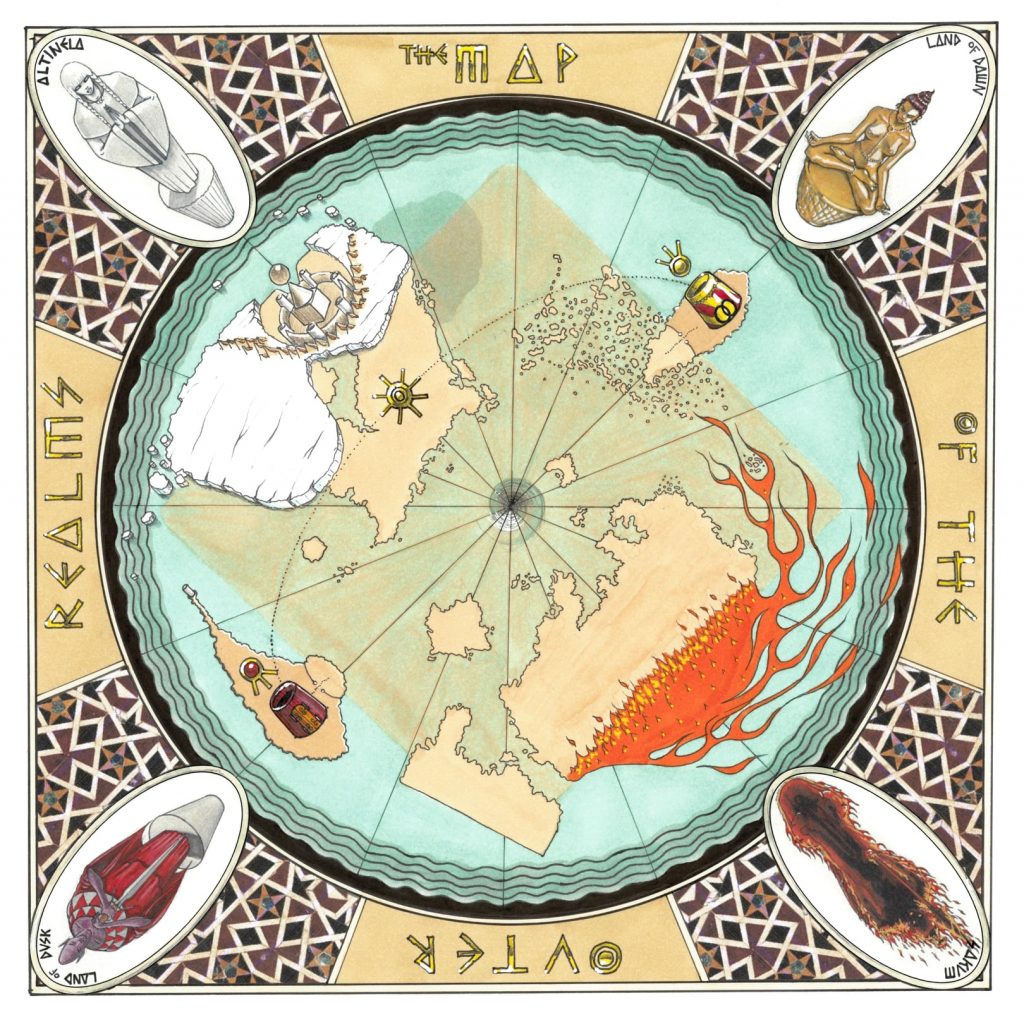
Unexpectedly, the conclave created or was presented with a new ecumenical syncretic form of Hrestoli Malkionism called the Abiding Book, which presented the Invisible God as an utterly simple, ineffable, unknowable entity which is both the creative source of existence and the teleological end of all existing things. The Invisible God created the Runes, the Powers, Elements, and Conditions, which slowly commingled and degenerated into gods, spirits, and mortals. All of creation was made understandable and knowable – with the exception of the Invisible God itself of course.
You can look up the Invisible God in previous issues of the Journal for more information and, most importantly, real-world inspirations.
This Abiding Book presented the true teachings of Malkion, and was consistent with the teachings of Hrestol, Zzabur, Gerlant, and Arkat – without need for the dangerous mysticism and irrational contradictions of Stygianism. The Abiding Book was a framework for understanding, and was an open invitation for exploring the cosmos. Everything could have its proper place within the framework of the Abiding Book, and the limited perspectives of the various barbarian cults could be put together to flesh out that framework.
About this time, the Jrusteli began experimenting with seagoing ships and began their first tentative challenges to the Waertagi.
OUROBOROS
Do you speak Dragon?
Around 650, some of the Orlanthi of Dragon Pass learned to speak with the Dragons. This opened tremendous mystical vistas for the Orlanthi, identifying the Cosmic Dragon as the Source and expanding their cosmological perspective.
The 650s are about one century into the era of the Empire of the Wyrms Friends as far as I can tell. Jörg points me to the timeline in the Guide, however, which show that in the 560s Rostand the Speaker was already teaching the “kernels of draconic consciousness”, and a decade later Vistikos Left-eye was establishing a “formula and pattern for a draconic human life”. It’s possible some of these figures, along with a few of their students, were the ones who opened up these channels of communication.
Unlike the Invisible God of the God Learners, insight into the Cosmic Dragon cannot be reached through materialistic logic – the identity of opposites, matters of duality and nonduality, formation of the “self”, and other such metaphysical questions.
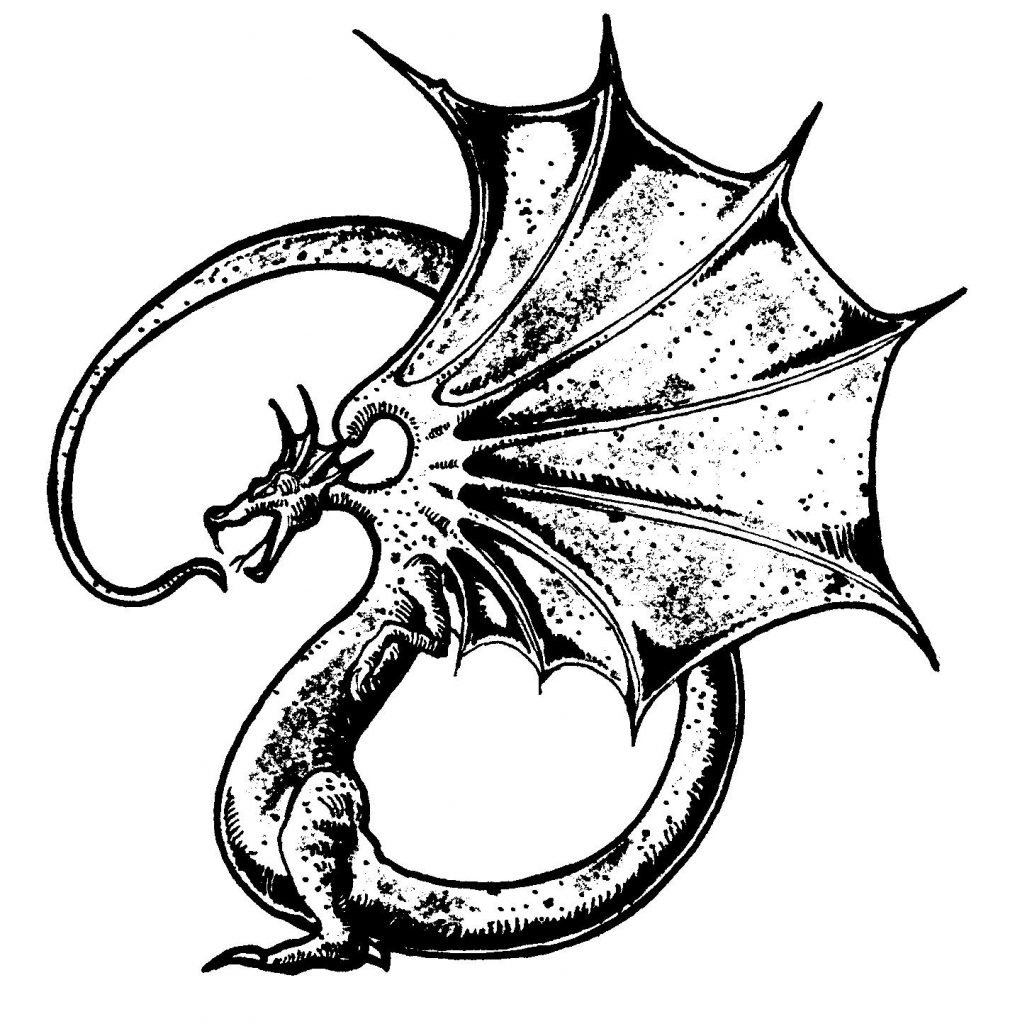
The following immortal dragonewt poem is a chant and prayer which relates to the creation of the world and was popular with the Wyrmfriends:
– Silence, The Infinite
O Zero, or an exclamation
OU A cry of pain; Ego
OUR Collectiveness, plurality.
OURO Collective emptiness
OUROB Creation (Collective with an end-stop “b”)
OUROBO Closed Infinity, or Being
OUROBOR Birth.
OUROBORO Nothing, emptiness.
OUROBOROS S= “Voice” (i.e. the sound a serpent makes).
We’ve seen this poem in a few places. Jörg points to Wyrm’s Footnotes 14, where the “Dragon Pantheon” is defined, and the above poem is tied to the Cosmic Dragon. We’ve also seen it recently in MOB’s tales of Yellow Mellow.
The poem shows a gradual internalization of something to bring about the formation of the concept of “self.” This poem was also repeated backwards at rituals and transported the chanters and the universe into mystical bliss which was ordinarily impossible to reach.
Ouroboros was sometimes worshiped as the Source and seen as the complement to Glorantha the World Goddess who was without consort or mate in her own realm. The phenomenal world is constantly changing and thus ultimately spiritually unreal – the gods themselves, although useful, do not reveal the hidden principles and implicit knowledge that created them and the universe.
Orlanth led the path towards draconic understanding. His openness to strangers meant it was easiest for his priests to speak to alien species. They learned that Orlanth embraced Arangorf the Inner Dragon, and that Orlanth had performed utuma for the Cosmic Dragon. Orlanth’s role as a cosmic creative-destroyer was promoted by the priests, sometimes to the near-exclusion of his other aspects.
Ok so this is getting interesting. “Utuma” is the term for the ritual suicide that Dragonewts commit when their time has come to get to the next evolutionary stage. You might remember that these weird little buggers can die many many times, and they always come back in a new body grown from the same egg. Only they sometimes come back with a new improved body as they reach the next of their five stages of evolution… which is why they get reaaaaally pissed off when humans go destroy their nest cities. Last time it happened, things didn’t go well for those humans. Anyway, so that’s what “utuma” is, although it’s also the term for the ritual dagger used for that ritual suicide.
Anyway, we know that Orlanth is big on fighting dragons: he had several adventures where this happened, the most famous one being his fight against Aroka (the Blue Dragon who kept all the rain inside it and caused drought in the lands). But I had somewhat glanced over in the Glorantha Sourcebook that he also killed Sh’harkazeel, the Cosmic Dragon. It’s originally framed as Orlanth being appointed by the other gods to go kill the Cosmic Dragon because it was awoken and was about to eat all of them… but it’s also called out that Orlanth had a chat with Sh’harkazeel and learned a bunch of draconic secrets, in exchange for performing utuma on the venerable dragon.
So depending on how you take the myth, Orlanth might be your classic dragon-slaying hero, or the confidante of a wise, ancestral, mystical dragon. This being Glorantha, he’s probably both. That’s why Orlanth is cool, I guess.
Through their draconic insights, the rulers of the Wyrms Friends had access to powerful dragon magic that terrified their enemies. Their mystics could dismiss even the most powerful of elementals or spells, terrify foes, deflect spells, breathe fire, or even become dragons themselves!
Summarizing the Second Age
Jeff takes a high-level view of the Second Age, a period of “widespread mythic experimentation and exploration”.
Not only did we have God Learnerism, dragonic mysticism, and syncretic developments in cults, but also there was an exploration of the God Time. This was a time of remarkable cult-changing heroes such as Pavis, Alakoring Rex, Gorangi Vak, Ingolf Dragonfriend, Carmanos, Verenmars, Jaldon Goldentooth, Delecti, and many more. This was the time that experimental artificial gods were created – and they proved to have magical power (although not necessarily as expected).
However, the Second Age ended in catastrophes worse than that of the First Age. The Oceans were closed to humans. Seshnela was sundered into fragments, Slontos sunk, and the Dragonkill War exterminated humans in Dragon Pass. Nature struck back against human hubris. After 1120, humans had learned to fear experimentation, exploration, and new ideas.
There were three main exceptions to this: the “resurrection” of the Red Goddess, the arrival of Belintar, and the rise of Sartar.
In 1220, a desperate cabal with nothing left to lose brought back into the world a goddess that had been destroyed in the God Time. Seeking weapons against her enemies, she tread paths in the Underworld and became lost there until she was Illuminated by Nysalor and returned with the Crimson Bat. She later rose into the Middle Earth as the Red Moon after appointing her son as her regent for her mundane affairs.
In 1313, a Stranger came ashore in Kethaela despite the Closed Seas. He made alliances with the Silver Age heroes of that lands, gained acceptance of their gods and goddess, and overcame the Only Old One, the dark lord of that land since prehistory. He instituted rites and ceremonies by which the Gods World could remain in proximity of the mundane world, and began the Tournament of the Masters of Luck and Death to keep those pathways active and empowered. Kethaela became known as the Holy Country because of this.
In 1470, a wanderer named Sartar came to Dragon Pass from the Holy Country. Without using violence himself, this wanderer united the quarreling Orlanthi of Dragon Pass, made friends with the dwarfs, centaurs, dragonewts, ducks, and werewolves, founded cities and built roads, temples, and libraries, and made himself King of Dragon Pass when he married the Feathered Horse Queen (another mythic adventurer from the Grazelands). He displayed the secrets and magic of Orlanth Rex, but also maintained draconic friendship. The kingdom he founded became rich on trade, and was influential far beyond its size and population.
This backstory helps explain the context of the Hero Wars, and gives ideas as to what they are all doing. Few if any of the main heroes are repeating the deeds of others. They are forging new paths, experimenting and exploring. Like your adventurers likely do!
Harrek the Berserk
Jeff takes a look at another big, epic, and iconic figure of the HeroWars: Harrek the Berserk. After all, the original Gloranthan game, White Bear & Red Moon, was named partially after him, not Argrath or whoever else.
Separating the stories of Harrek from the truth of his life is nearly impossible – certainly Irrippi Ontor has so far failed to do so. Harrek was, as far as any can tell, initially a normal Rathori warrior. There are rumors that Syndic’s Ban was somehow connected to his adulthood initiation but those are but rumors. What is known is that after he awakened in 1594, he was extraordinary. For over a decade, Harrek wandered the world without – both the mundane world AND the mythic realms. Stories of him as a penniless mercenary, a slave, a Lunar gladiator, etc., are often associated with this time. In 1605 he received training as a Dart Warrior.
Rathori are bear Hsunchen people, similar to, say, how Telmori are wolf Hsunchen people. They’re typically from Fronela.
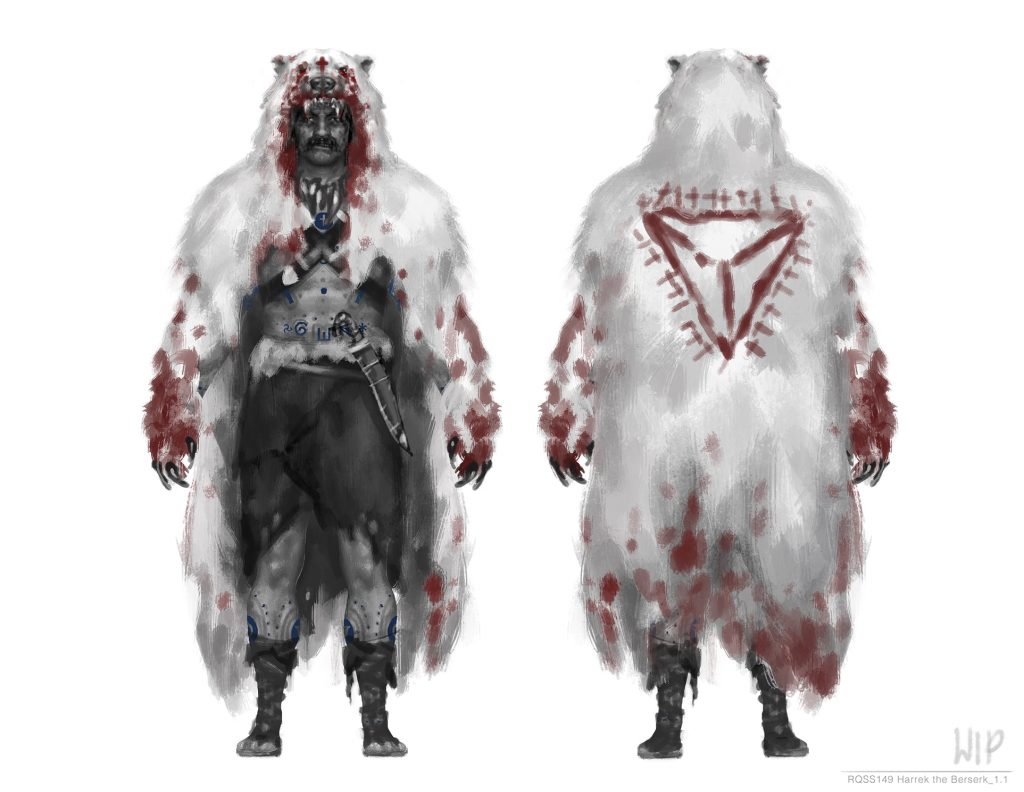
In 1607, as part of a Dart War, Harrek killed the Red Emperor and fled through the wilds of Dorastor to escape. Harrek is known to hate the Red Emperor and the Red Goddess with an overwhelming passion – it is thought this hatred originates from those experiences.
Harrek’s training as a Dart Warrior means he was basically a black-ops operative for the Red Emperor, or for one of the leading households of the Empire. He probably witnessed the worst side of the Lunars during that time, which played into his later hatred of it.
And then in 1609, Harrek slew and bound the White Bear God – and now always wears its skin and claws. After this, Harrek was no longer merely extraordinary – he was a superhero, a shaman with a god as a fetch, a demigod of destruction and disorder. Constantly wandering through this world and the Mythic Realm, Harrek is constantly seeking treasures, weapons, and fame. But his goals are erratic. He’s thrown away fortunes and even kingdoms for further adventure, traveled all the way around the world, and quested along unknown paths.
Oh that’s interesting: I thought the white bear god was a bound spirit for Harrek, but it’s actually his fetch… which means that a fetch is not necessarily your own “awakened” spirit, but can be another spirit you “acquire” somehow during your initiation? Interesting. I guess that brings exciting possibilities if you have a very ambitious shaman in your party, especially if they take an unusual path towards shamanism. In particular, Jeff commented:
I personally find the idea of a self-initiated shaman terrifying.
What about Harrek’s Facebook profile?
Harrek is said to be loyal only to Gunda, his Shield Maiden. His relationship with Argrath is more complicated; Argrath is the closest thing Harrek has to a true friend, but they also come to blows on several occasions. Harrek has an intense and inflexible hatred for the Lunar Empire and everything in it.
Given Harrek’s hatred of the Lunars, you might wonder why he still worked for them in a couple occasions, like the taking of the city of Karse, or the destruction of the Holy Country’s fleet. Personally, I interpret these as some other Wolf Pirates doing these things (Harrek isn’t necessarily the leader of all Wolf Pirates… they existed before him), but Jeff also offers another explanation:
One theory is that Harrek’s hatred is very personal (and focused on the Red Goddess, Red Emperor, and the demigods around them) and he didn’t appreciate that Gimgim the Grim or whoever brokered the deal was an agent of the distant Red Emperor.
Gimgim the Grim is a secret operative of the Red Emperor, who was at some point posted in Pavis to gather intelligence and run operations in Prax.
Harrek can be thought of as a great random factor throughout the Hero Wars. And one who does not fit easily within anyone’s models or frameworks.
Harrek’s combination of power – both physical and spiritual – with his unpredictability makes him perhaps the most dangerous protagonist in the Hero Wars.
Harrek is savage and uncivilised, but he’s also been trained by the Lunars, been to Dorastor, plundered cities in Fronela, Teshnos, Fonrit, and Seshnela. He’s definitely no fool and has bestial cunning.
Heroquesting
Jeff hopes that people will have moved on from heroquesting as pictured in the King of Dragon Pass computer game, or the HeroWars/HeroQuest books.
Every culture performs ceremonies and rites that cause the mundane and divine worlds to overlap into what is called the Hero Plane. This is where you get your Rune magic from, your allied spirits, befriend cult spirits, and all that stuff.
Now that stuff is gameable, but it really only gets interesting IMO when things go wrong. When the ceremony no longer predictably works, when dangerous enemies show up, etc.
So this is what heroquesting has mostly been about since the HeroWars/HeroQuest line: you go in thinking you know what’s going to happen, but the gamemaster throws in a bunch of surprises and twists. Jeff goes farther:
But far more interesting to me is deliberately exploring the mythic realms and discover previously unknown paths through the divine world. This is what heroes such as Alakoring, Argrath, Arkat, the Feathered Horse Queen, Harmast, Harrek, Jaldon Goldentooth, Pavis, Sir Ethilrist, Cragspider, Jar-eel, Hwarin Dalthippa, Hon-eel, and the Red Goddess. They did not “invent” new myths – they traveled previously unknown paths through the Hero Plane and brought back their experiences to the mundane world. They discovered paths and events that had always been latent in the God Time.
Being a recent convert to Glorantha, and playing with people who didn’t know anything either until a few game sessions ago, I have to say you probably need to do the former before you do the latter. Players need to know that heroquesting is a thing, how it works, and what it can give them, before they can start making it their own with advanced exploratory heroquesting.
And this ties a lot into rules and world-building to me. On the one hand, heroquesting is supposed to be very dangerous and require lots of magical support, but on the other hand we want to facilitate it for players to go wild with it. But it’s easy to undermine the heroquesting prowess of Kallyr, King Broyan, or even Belintar if that kind of advanced heroquesting can also be done by the thanes of Apple Lanes after a few seasons of adventuring in Colymar lands. Without going into details (that’s maybe for a future Runic Rants article), there are a few ways to resolve this conundrum depending on your players and your campaign:
- If you have ambitious players, let them become leaders, and give them followers that can (at least narratively) provide magical support for big heroquesting.
- Decide that actually anybody can move the heavens… it’s just that farmers have better things to do, and other thanes are not crazy enough to try it.
- Make the adventurers join the entourage of big NPCs like Kallyr or Argrath, and have some missions essentially be about going heroquesting somewhere to figure out some kind of weakness in an enemy, find some advantage, or whatever else. The mission giver doesn’t have any precise instructions: “just figure it out“.
This approach to heroquesting was fairly common in the late First Age and through the Second Age. Most people shunned it after the cataclysms that ended that Age. BUT not everywhere – in the Lunar Empire and the Holy Country this sort of spiritual exploration remained, although for very different ends. And Sartar and his dynasty inherit the techniques developed in the Holy Country.
As the Hero Wars develop, the protagonists take more risks and gambles in their heroquesting – such as rediscovering the techniques of the God Learners and the Empire of the Wyrms Friends, using Chaotic magic in heroquests, and more. People take short cuts, make permanent changes for short-term gains, and all the sorts of things that people do when they are desperate and ambitious. That becomes the Hero Wars. We start from a familiar starting point, but by the end, the world has changed so much we can barely recognize where we began.
So I guess this gives weight to the second option from above: people are just warming back up to doing “creative” heroquesting, and the adventurers are part of the “innovators” or “early adopters” of the heroquest techniques adoption cycle.
Jeff concludes with this:
It is important to keep in mind that underlying Glorantha are the Runes and other archetypes. These archetypes are more real than reality. We know that the Runes joined together, came into conflict, devolved, and made the world we live in. But how we interact with these archetypes is based on our experiences which in turn is the foundation of our understanding of it all.
Repeating somebody else’s story is not the point of heroquesting – nobody becomes a hero by simply being the understudy! One becomes a hero by making your own path through the mythic realm of archetypes and Runes. Make the divine and eternal the personal and psychological!
Cults Friendly or Neutral to Chaos
From a question posed on the Facebook group about cults friendly or neutral to Chaos, Jeff’s answer gives a sneak peek at some cult relationships from the upcoming Cults book:
Let’s put aside cults with the Chaos Rune (Red Goddess, Nysalor, Thed, Vivamort, Crimson Bat, etc.) or weird specific Chaotic cult specific associations (like Thed and Daka Fal) and just look at non-Chaotic cults that are Friend towards Primal Chaos:
Hon-eel
Hwarin Dalthippa
Yara Aranis
And those neutral towards Primal Chaos:
Black Fang
Etyries
Gorgorma
Humakt
OuraniaAnother short (but interesting) list.
Yelm is an Enemy of Primal Chaos. He makes a few Chaotic exceptions – Red Goddess and Nysalor – but in general he hates Chaos.
As an aside, Yelm is Neutral not Hostile let alone an Enemy of Orlanth. And vice versa. If Orlanth was enemies of every god he fought with, he’d have no friends at all! And if Yelm was enemies with every rebel god, he’d have nothing to rule!
Community Roundup
The community roundup is our highlight of interesting things being mentioned in the Glorantha-related Facebook groups, sub-Reddits, and other similar online places.
RuneQuest Year Zero Podcast
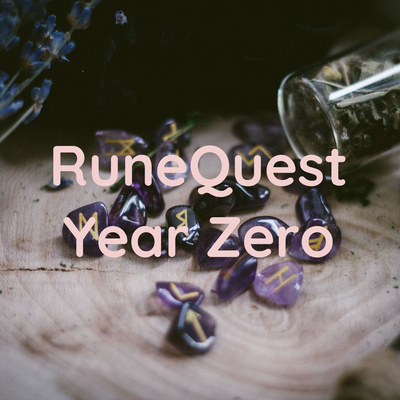
Painted Mad Knight Pre-gens
Phil Leedell did an awesome job painting Mad Knight’s RuneQuest pre-gens! I love how vibrant those colours are:
That’s the culmination of a year of miniature painting:
[…] I managed to paint 178 miniatures this year and most of them were Gloranthan.

Felix Figure Paintings’ Gloranthan Works
Felix Figure Paintings does, well, figure paintings, of a large array of collections and styles. Here are some Dragonewts, and some Lunar soldiers.
Thank you for reading
That’s it for this week! Please contact us with any feedback, question, or news item we’ve missed!



